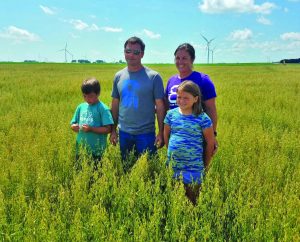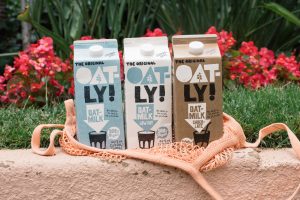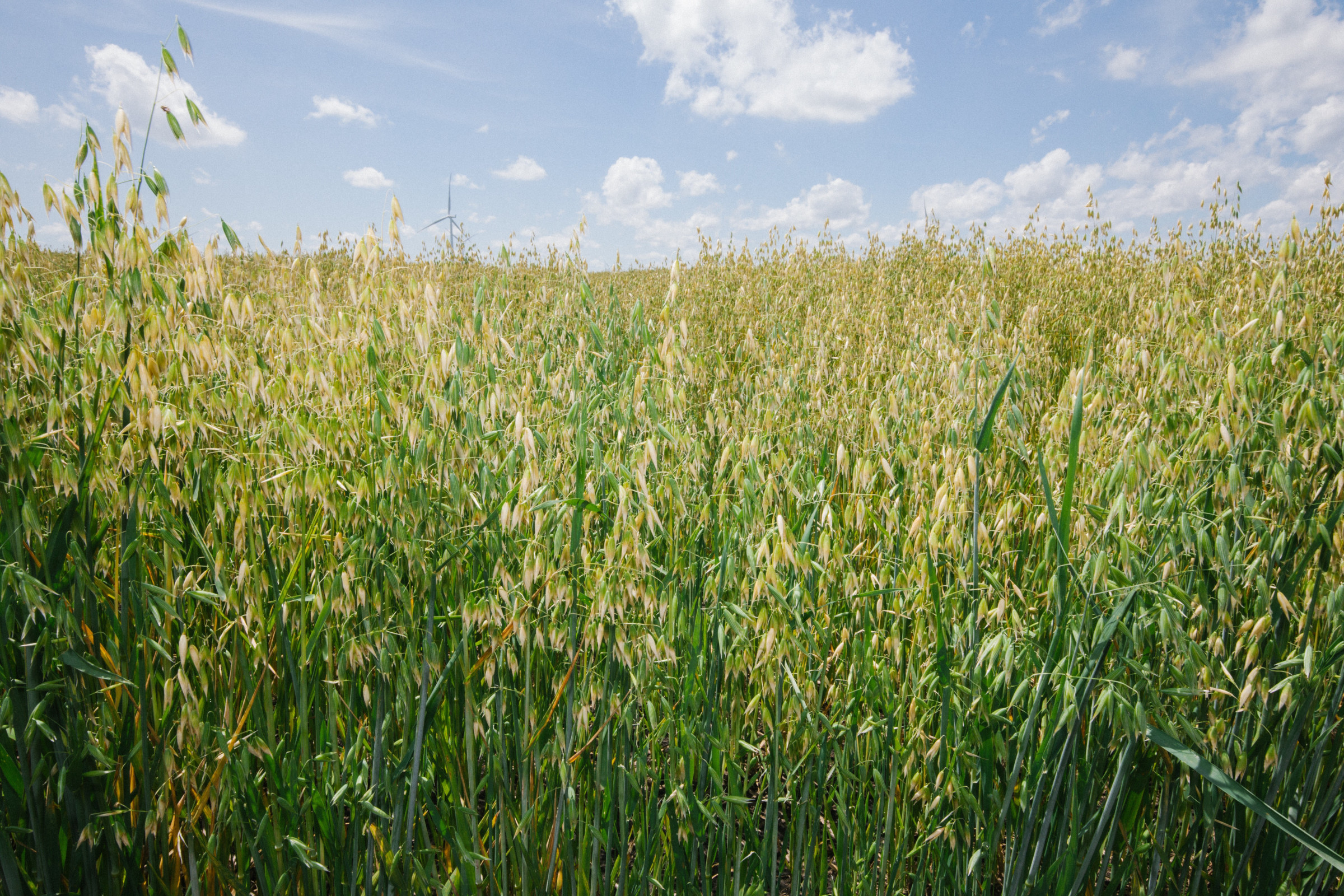Growing oats in Iowa has declined significantly in recent years, falling from more than six million acres in the 1950s to just 33,000 acres in 2018. But a new collaboration between Practical Farmers of Iowa (PFI), oat milk manufacturer Oatly, and Grain Millers may lead to a revival of sustainable oat production in Iowa and other Midwest states.
Soil health and reduced nitrogen and herbicide use benefits

Iowa farmer A.J. Blair along with his wife Kellie, son, Wyatt, and daughter, Charlotte grew oats for Oatly. Photo courtesy of Practical Farmers of Iowa
PFI, a farmer education organization with 3,000 members, has been spearheading efforts to encourage Midwest farmers to add small grains such as oats, wheat, barley, rye, and triticale to their corn and soybean crop rotations. Published research by Iowa State University agronomist Matt Liebman has found that adding a small grain such as oats to crop rotations can significantly reduce nitrogen fertilizer runoff, soil erosion, and herbicide use, while increasing crop yields and farm profitability.
“Our members identified that they want to grow more small grains because there are a lot of benefits from a farmer perspective,” says Alisha Bower, PFI’s strategic initiatives manager.
The challenge with growing small grains is finding markets. The grain handling system in Iowa and other Midwest states is structured for corn and soybeans. Farmers can’t take their oats to a local grain elevator, which isn’t likely equipped to handle them.
In 2016, PFI received a Conservation Innovation Grant (CIG) from the National Resource Conservation Service (NRCS), which offers a cost share of $25 per acre to farmers for growing a small grain followed by a cover crop. The cost share helps to reduce the risk of growing small grains if markets aren’t available.
“We started to ask: can we buy U.S. oats?”
In 2017 and 2018, PFI and Sustainable Food Lab, a non-profit that helps food companies implement sustainability innovations, co-hosted events attended by representatives of major food and beverage companies to highlight the ecological benefits of adding small grains to crop rotations.
Through these meetings, PFI connected with Oatly, a Sweden-based oat milk manufacturer that had expanded to the U.S. in 2016.
“When we came to the U.S. it was important to us as a company focused on sustainability to establish operations here,” says Sara Fletcher, Oatly’s communications and public affairs lead. “We started to ask: can we buy U.S. oats? Is it possible and would that benefit us from a sustainability perspective and also benefit the farmers and the land?”
Oatly, which is seeing strong demand for its oat milk products in the U.S., has been purchasing oats from Canada where most of the food-grade oats in North America are grown.
“Oatly said ‘we buy oats, and we’d like to support farmer profitability and local market development, so how can we work together on this?’ ” Bower says.
Working with PFI, Oatly launched a pilot project to source oats from Midwest farmers. Four farmers in Iowa and Minnesota were recruited to grow oats in 2019 as part of their corn and soybean crop rotations. They would also grow a cover crop that would be planted after the oats were harvested. The farmers would receive the $25 per acre cost share from PFI as part of the NRCS grant. Minneapolis-based Grain Millers would buy the oats from the farmers on a three-year contract and supply them to Oatly.
“We want to see if we can get more oats in southern Minnesota and northern Iowa where they’re shown to be beneficial for soil health and try to convince growers that it can be profitable as well,” says Beth Stebbins, program coordinator, sustainability program at Grain Millers.
Breaks pest, weed cycles, improves water quality, reduces greenhouse gases
Oats are a cool season crop that’s planted in early spring and harvested in mid-summer. By contrast, corn and soybeans are planted later in the spring and harvested in fall, and the short two-crop rotation is susceptible to insect pests and weeds. Planting oats earlier followed by a cover crop like clover or peas helps to break the insect and weed cycles, reducing the amount of herbicides used.
Water quality, a major issue in Iowa and other Midwest states because of nitrogen runoff into waterways, is also improved by having roots in the ground throughout the year.
“Having oats growing in the field in April, a rainy month, soaks up water to prevent soil erosion and keep nutrients from flowing down to the Gulf of Mexico,” Bower says.
Perhaps the biggest benefit to growing oats is the potential for reducing greenhouse gas emissions from agricultural production, which contribute to climate change. According to Matt Liebman’s research, a clover cover crop grown after oats can add enough nitrogen to the soil to reduce a farmer’s need for fossil fuel-based nitrogen fertilizer by as much as 80 pounds.
“We’re avoiding a lot of emissions by reducing those fertilizer applications,” Bower says.
“Our source ingredient (oats) can have an active role in mitigating climate change; it’s very exciting,” Fletcher says.
Another benefit to growing oats in the U.S. is that farmers here won’t desiccate or dry them down with glyphosate herbicide, a practice that is common on oats in Canada.
“It’s not an issue with U.S. growers. In the U.S., oats are harvested in July and it’s pretty dry,” says Eric DeBlieck, Grain Millers crop specialist.
Grain Millers also has a policy to not accept oats that have been desiccated with glyphosate.
“Growers did the best they could”
The four farmers recruited for the pilot project planted oats this year on about 500 acres combined.
Fletcher says they were initially a little skeptical. “There was a mixed response to the idea of oat milk; one farmer said he’d rather eat his oats. But there was excitement around growing of the oats and to see the commitment from Grain Millers as buyer and from Oatly as the final market as well.”

Oatly oat milk products
One of the farmers, Jordan Ellis, in Graettinger, Iowa, says he was excited but also “a little intimidated” about growing oats.
“Adding a third crop in our rotation was something we really want to do. Oats seemed like a good fit,” he says.
Despite Iowa’s history of producing oats, there is a lack of information about how to do it since it has fallen out of favor in recent years.
“One of the challenges is that we haven’t had a lot of research and development in oats and oat production for a long time,” Bower says. “There are a limited number of farmers doing this, and not a lot of info on best practices or how to do it.”
The farmers also faced a challenging year for planting with heavy rains in the Midwest last spring, which reduced the yields.
Despite the weather challenges, the farmers produced an acceptable crop of oats. Three of the four farmers met Grain Millers’ 36-pound test weight specification for food grade oats.
“A good amount of the oats made food grade specifications, which is fantastic,” Fletcher says.
“The growers really did the best they could to get the best crop they could with the weather conditions. We’re fairly happy,” DeBlieck says.
PFI is tracking results of the pilot program, quantifying economic and environmental data based on surveys with the farmers.
“The idea is to track the farmers’ data over three years to see if oats are profitable and can be part of a profitable rotation, which is shown to be better for the environment,” Stebbins says.
For farmers who don’t meet food-grade specifications, Grain Millers also offers the opportunity to sell their oats for animal feed.
“We’re trying to offer alternative markets if a food-grade market specification isn’t met,” DeBlieck says.
In fact, oats for feed is a much bigger potential market for farmers. Only two million acres of oats is needed to supply the market for food products such as oatmeal, cereals, and oat milk. By contrast, livestock consume 23 times more oats than people, according to Bower.
“Growing oats for food is definitely an important shift, but from a birds eye view of land use in the U.S. it would hardly move the needle,” she says. “For broader change we need to engage the feed and fuel sectors which dominate the uses of grain grown in this country. We know we can feed oats and other small grains to livestock, so that seems like a good place to start.”
“Raising food, not just a crop”
Oatly is happy with the first year’s results. Fletcher says there was a lot of learning and the collaboration with PFI and Grain Millers is “one of the best partnerships I’ve ever been involved in.”
“There is so much good energy about finding ways to be innovative in agriculture and finding ways to connect private companies like us directly with growers.”
Stebbins is also happy with the pilot project.
“The growers really like the program and working with Oatly. All in all I think everyone is pretty happy with the program,” she says.
“I think it’s good,” Ellis says. “To have a company like Oatly along with Grain Millers and PFI offer that incentive for a specific crop; it’s something that can lead farmers to say ‘yes let’s give a shot.’ ”
Oatly wants to expand the project. “How do we scale this up? How do we insure that this goes from a pilot to part of our sourcing? That is a question that we are trying to figure out,” Fletcher says.
The project will expand in 2020 with the goal of increasing the number of farmers participating to 12-15 and the oat acres to 1500.
“The more acres the better,” Fletcher says.
More farmers are interested. “I’ve gotten phone calls out of the blue from many farmers about participating. I’m hopeful,” Bower says.
Overall, the number of oat acres in Iowa has grown from 33,000 in 2018 to 80,000 in 2019.
Fletcher thinks the project can create a model for sourcing directly from farmers that other, larger food manufacturers can follow.
“Consumers are curious about where their food comes from; they want to have a connection with the farmers who are growing the oats in their oat milk.”
One of those farmers, Jordan Ellis, has gone from being skeptical about oat milk to feeding it to his one-year-old son, Knox, who has trouble digesting cow’s milk.
“It’s exciting to raise a food source for a product that will be used in our family as a necessity. Another thing is that, as farmers, we are raising food, not just a crop,” he says.





